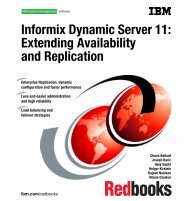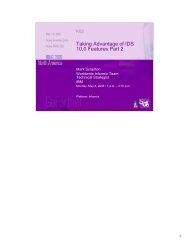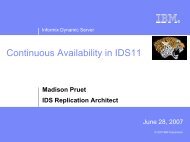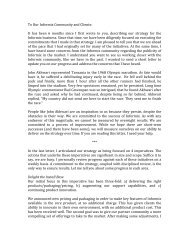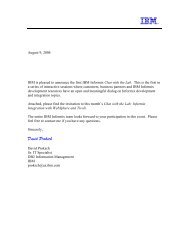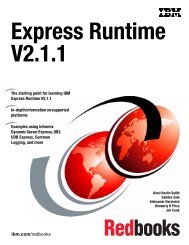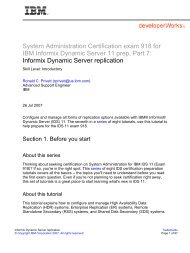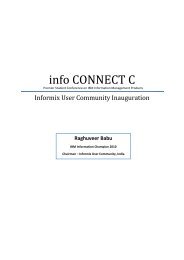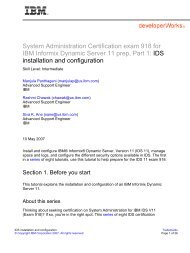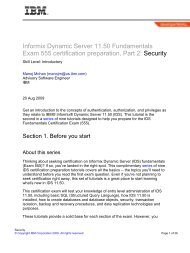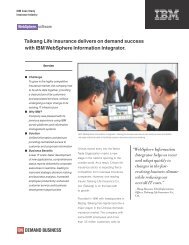Anatomy of a DB2 Attack - International Informix Users Group
Anatomy of a DB2 Attack - International Informix Users Group
Anatomy of a DB2 Attack - International Informix Users Group
You also want an ePaper? Increase the reach of your titles
YUMPU automatically turns print PDFs into web optimized ePapers that Google loves.
H08<br />
<strong>Anatomy</strong> <strong>of</strong> a<br />
<strong>DB2</strong> <strong>Attack</strong><br />
Aaron Newman<br />
Application Security, Inc.<br />
May 9, 2006 • 8:30 a.m. – 9:40 a.m.<br />
Platform:<strong>DB2</strong> UDB for Linux, Unix, Windows<br />
1
Main Points<br />
• State <strong>of</strong> <strong>DB2</strong> Security<br />
• Securely Configuring <strong>DB2</strong><br />
• Securing <strong>DB2</strong> in a Web Application<br />
• Database Vulnerabilities<br />
• Remote Command Execution Demo<br />
• Conclusions & Questions<br />
www.appsecinc.com<br />
2
State <strong>of</strong> <strong>DB2</strong> Security<br />
3
Evolving DB Threat Environment<br />
• A decade ago, databases were:<br />
• Physically secure<br />
• Housed in central data centers – not distributed<br />
• External access mediated.<br />
• Security issues rarely reported<br />
• Now increasingly DB’s externally accessible:<br />
• Suppliers/Customers directly connected<br />
• Customers & partners directly sharing data<br />
• Data is most valuable resource in application stack<br />
• Value increases with greater integration & aggregation<br />
• Opportunities for data theft, modification, or destruction<br />
• DB security a growing problem:<br />
• Need to design for & test for high threat public internet scenario<br />
• Recommend defense in depth<br />
www.appsecinc.com<br />
4
What about perimeter security?<br />
Barrier Defense Is No Longer Enough<br />
Firewall<br />
Web<br />
Proxy<br />
Main Office Network<br />
Internet<br />
CRM<br />
Business Partner’s<br />
Network<br />
Firewall<br />
VPN<br />
Internet<br />
Firewall<br />
VPN<br />
Secret<br />
Formula<br />
Accounting<br />
Financial<br />
HR<br />
Remote Office Network<br />
Remote<br />
Employees<br />
www.appsecinc.com<br />
5
Application Threats & Vulnerabilities<br />
An Escalating Problem<br />
SQL Database Vulnerabilities<br />
Vulnerabilities that affect relational databases are<br />
another class <strong>of</strong> threats that experienced substantial<br />
growth over the past year. Many <strong>of</strong> these vulnerabilities<br />
were highly severe in nature because they enable<br />
attackers to gain complete control <strong>of</strong> a database.<br />
This year, Symantec documented over 65 vulnerabilities<br />
affecting database products from Micros<strong>of</strong>t, Oracle and<br />
IBM.<br />
Symantec Internet Security Threat Report - <strong>Attack</strong> Trends<br />
www.appsecinc.com<br />
6
Forrester on Database Security<br />
Firms Need it<br />
“…with growing incidence <strong>of</strong> intrusions across<br />
industries and strong regulatory requirements<br />
to secure private data, enterprises need to<br />
make DBMS security a top priority.”<br />
Source: Comprehensive Database Security Requires Native DBMS<br />
Features And Third-Party Tools, Forrester Research, Inc., March 29, 2005<br />
www.appsecinc.com<br />
7
External threats<br />
• Exposing a database to the Internet<br />
• DO NOT DO THIS!<br />
• Protocol stacks are riddled with overflows<br />
• ALL the database vendors!<br />
• Behind a firewall<br />
• Recommend data be served through web app<br />
• Still vulnerable to application level attacks<br />
• Still vulnerable to internal attacks<br />
www.appsecinc.com<br />
8
Internal threats<br />
• Need to focus less on people getting through perimeter<br />
• Need to focus more on securing data at the source<br />
• <strong>Attack</strong>s from DBAs, sysadmins, and legimate users<br />
• Need to focus not only on vulnerabilities<br />
• Be able to see who is doing what in your applications<br />
• Providing auditing and accountability for users and database administrators<br />
• Being able to identify malicious activity<br />
http://www.thesmokinggun.com/archive/0623042aol1.html<br />
“JUNE 23--An AOL s<strong>of</strong>tware engineer was arrested today for stealing<br />
the company's entire subscriber list--totaling 92 million screen<br />
names--and selling it to a 21-year-old Las Vegas spammer. “<br />
www.appsecinc.com<br />
9
Securely Configuring <strong>DB2</strong><br />
10
Configuring Authentication<br />
• Controlling where authentication occurs<br />
• NEVER allow server to accept CLIENT authentication<br />
• Allows client to authenticate the user (trust_allclnts)<br />
• inherently insecure<br />
• Recommended settings<br />
• DCE_ENCRYPT<br />
• SERVER_ENCRYPT<br />
• KRB_SERVER_ENCRYPT<br />
• Discouraged setting<br />
• CLIENT<br />
• SERVER<br />
www.appsecinc.com<br />
11
Encryption During Authentication<br />
• Controlling passwords as they traverse the<br />
network<br />
• ALWAYS require *_ENCRYPT protocols<br />
• All passwords encrypted by <strong>DB2</strong> at client before sent to<br />
server<br />
• WARNING<br />
• You must set clients to use *_ENCRYPT protocols<br />
www.appsecinc.com<br />
12
<strong>DB2</strong> CONNECT Packet<br />
• Below is an example <strong>of</strong> a connection:<br />
• account is “User”, password is “3”<br />
www.appsecinc.com<br />
13
Default Username/Passwords<br />
• Installed with the database<br />
• db2admin/db2admin<br />
• db2as/ibmdb2<br />
• dlfm/ibmdb2<br />
• db2inst1/ibmdb2, db2inst2/ibmdb2, etc…<br />
• db2fenc1/ibmdb2, db2fenc2/ibmdb2, etc…<br />
• Others installed with 3 rd party products<br />
• Ensure you have enabled password management features<br />
• Password lockout to 10<br />
• Password expiration to 90 days<br />
www.appsecinc.com<br />
14
Demo –<br />
Password attacks<br />
15
Locking down OS Privileges<br />
• Unix/Linux<br />
• Set all <strong>DB2</strong> file permissions to –rwxrwx--- or more restrictive<br />
• Do not run daemon as root<br />
• Rename OS accounts and select strong password<br />
• Windows<br />
• Set file permissions to Owner only<br />
• Do not run service as LocalSystem<br />
• Run service as local non-privileged user<br />
• Lock down registry permissions on <strong>DB2</strong> keys<br />
www.appsecinc.com<br />
16
Locking down database privileges<br />
• Remove all permissions granted to public<br />
• Review users granted SYSADM group<br />
• Revoke privileges on system catalogs<br />
• SYSIBM.DBAuth<br />
• SYSIBM.TabAuth<br />
• SYSIBM.INDEXAuth<br />
• SYSIBM.COLAuth<br />
• SYSIBM.SCHEMAAuth<br />
• SYSIBM.PASSTHRUAuth<br />
• Create UDFs as fenced<br />
www.appsecinc.com<br />
17
Securing <strong>DB2</strong> in a Web Application<br />
18
Can attacks go through a firewall?<br />
• YES!!!<br />
• Firewall configuration<br />
• Block access through port 523, 50000-50010, 446<br />
• Only allow traffic to port 80<br />
• Block UDP as well as TCP<br />
• SQL Injection<br />
• Not specific to <strong>DB2</strong><br />
• a web programming problem<br />
www.appsecinc.com<br />
19
How Does It Work?<br />
• Modify the query<br />
• Change:<br />
• To:<br />
• Select * from my_table where column_x = ‘1’<br />
• Select * from my_table where column_x = ‘1’ UNION<br />
select credit_card_number from orders where ‘q’=‘q’<br />
www.appsecinc.com<br />
20
Example JSP Page<br />
Package myseverlets;<br />
<br />
String sql = new String(“SELECT * FROM Web<strong>Users</strong><br />
WHERE Username=’” +<br />
request.getParameter(“username”) + “’ AND<br />
Password=’” + request.getParameter(“password”) + “’”<br />
stmt = Conn.prepareStatement(sql)<br />
Rs = stmt.executeQuery()<br />
www.appsecinc.com<br />
21
Valid Input<br />
• If I set the username and password to:<br />
• Username: Bob<br />
• Password: Hardtoguesspassword<br />
• The sql statement is:<br />
• SELECT * FROM Web<strong>Users</strong> WHERE<br />
Username=’Bob’ AND<br />
Password=’Hardtoguess’<br />
www.appsecinc.com<br />
22
Hacker Input<br />
• Instead enter the password:<br />
• Aa’ OR ‘A’=‘A<br />
• The sql statement now becomes:<br />
• SELECT * FROM Web<strong>Users</strong> WHERE<br />
Username=’Bob’ AND Password=’Aa’ OR<br />
‘A’=‘A’<br />
• The attacker is now in the database!<br />
www.appsecinc.com<br />
23
Selecting from other Tables<br />
• To select data other than the rows from<br />
the table being selected from.<br />
• SQL statements are UNIONed with other<br />
tables or views.<br />
www.appsecinc.com<br />
24
Sample ASP Page<br />
Dim sql<br />
Sql = “SELECT PRODUCTNAME FROM<br />
PRODUCT WHERE ProductName=’” &<br />
product_name & “’”<br />
Set rs = Conn.OpenRecordset(sql)<br />
‘ return the rows to the browser<br />
www.appsecinc.com<br />
25
Valid Input<br />
• Set the product_name to :<br />
• DVD Player<br />
• The SQL Statement is now:<br />
• SELECT PRODUCTNAME FROM PRODUCT<br />
WHERE ProductName=’DVD Player’<br />
www.appsecinc.com<br />
26
Hacker Input<br />
• Set the product_name to :<br />
• test’ UNION select credit_card_number from<br />
CUSTOMERS where ‘a’ = ‘a<br />
• The SQL Statement is now:<br />
• SELECT PRODUCTNAME FROM PRODUCT<br />
WHERE ProductName=’test’ UNION select<br />
credit_card_number from CUSTOMERS where<br />
‘a’=‘a’<br />
www.appsecinc.com<br />
27
Reverse Engineering Database Schema<br />
• Hacker doesn’t know the database schema<br />
• Can they figure it out?<br />
• Yes!!!<br />
• UNION SQL statement with tables from system catalog<br />
• Tables with information<br />
• SYSIBM.SYSTABLES<br />
• SYSIBM.SYSCOLUMNS<br />
• SYSIBM.SYSSERVERS<br />
• Retrieving the list <strong>of</strong> tables<br />
• UNION select name from SYSIBM.SYSTABLES;<br />
www.appsecinc.com<br />
28
Preventing SQL Injection<br />
• Bind variables – don’t concatenate SQL strings<br />
• Right way<br />
• String sql = new string(“UPDATE EMPLOYEE<br />
SET BONUS=?“<br />
• Wrong way<br />
• String sql = new string(“UPDATE EMPLOYEE<br />
SET BONUS=“ + request.getParameter(“bonus”)<br />
www.appsecinc.com<br />
29
Demo –<br />
SQL Injection<br />
30
Database Vulnerabilities<br />
31
What is a buffer overflow<br />
• When a program attempts to write more data<br />
into buffer than that buffer can hold…<br />
• …Starts overwriting area <strong>of</strong> stack memory<br />
• That can be used maliciously to cause a program to<br />
execute code <strong>of</strong> attackers choose<br />
• Overwrites stack point<br />
www.appsecinc.com<br />
32
Mechanics <strong>of</strong> stack-based buffer overflow<br />
• Stack is like a pile <strong>of</strong> plates<br />
• When a function is called,<br />
the return address is<br />
pushed on the stack<br />
• In a function, local<br />
variables are written on the<br />
stack<br />
• Memory is written on stack<br />
• char username[4] reserved 4<br />
bytes <strong>of</strong> space on stack<br />
return<br />
function<br />
local<br />
stack<br />
memory<br />
0X0123<br />
\0<br />
s<br />
y<br />
s<br />
0X0691<br />
0X0690<br />
0X0689<br />
0X0688<br />
0X0687<br />
0X0686<br />
0X0685<br />
0X0684<br />
www.appsecinc.com<br />
33
Mechanics <strong>of</strong> stack-based buffer overflow<br />
• When function copies too<br />
much on the stack<br />
• The return pointer is<br />
overwritten<br />
• Execution path <strong>of</strong> function<br />
changed when function<br />
ends<br />
• Local stack memory has<br />
malicious code<br />
return<br />
function<br />
local<br />
stack<br />
memory<br />
0X0123 0X0686<br />
X<br />
X<br />
X<br />
X<br />
0X0691<br />
0X0690<br />
0X0689<br />
0X0688<br />
0X0687<br />
0X0686<br />
0X0685<br />
0X0684<br />
www.appsecinc.com<br />
34
Installing the latest FixPak<br />
• Usually addresses latest buffer overflows<br />
• Most current versions<br />
• V6.1 – Upgrade to V7.2 or V8.1<br />
• V7.1 – Upgrade to V7.2<br />
• V7.2 – Fix Pak 13<br />
• V8.1 – Fix Pak 9<br />
• Download from<br />
• http://www-4.ibm.com/cgibin/db2www/data/db2/udb/winos2unix/support/download.d2w/<br />
www.appsecinc.com<br />
35
Denial <strong>of</strong> Service attacks<br />
• Denial <strong>of</strong> service allows an attacker to bring down the<br />
database<br />
• Affects availability <strong>of</strong> the database<br />
• Two functions used to crash the database engine<br />
• select to_char(‘test’, ‘’) from sysibm.sysdummy1<br />
• select to_date(‘test’, ‘’) from sysibm.sysdummy1<br />
• Requires no special privileges in database<br />
• Fixed in: <strong>DB2</strong> version 8.1 FixPak 8<br />
www.appsecinc.com<br />
36
Local Privilege Escalation <strong>Attack</strong>s<br />
• Some attacks can be used to become privileged users<br />
• Based on a non-privileged user on the UNIX operating system<br />
• Find files that are setUID – runs under file owners privileges<br />
• Most dangerous when setUID file is owned by root<br />
• File used to run fenced libraries - db2fmp<br />
• Installed setUID root<br />
• Buffer overflow occurs when passing in overly long parameter<br />
• Fixed in<br />
• <strong>DB2</strong> version 7.2 FixPak 13, version 8.1 FixPak 8<br />
www.appsecinc.com<br />
37
Buffer overflow in SQL functions<br />
• Must have a user ID in the database<br />
• May or may not require special privileges<br />
• Example: generate_distfile procedure<br />
• Overly long string as an argument<br />
• Cause a stack-based buffer overflow<br />
• Function exported by db2dbappext.dll<br />
• Third parameter <strong>of</strong> the function is a file name<br />
• Affects both Windows and UNIX<br />
www.appsecinc.com<br />
38
JDBC Applet Server buffer overflow<br />
• JDBC Applet Server and Control Center<br />
• Runs on port 6789 and 6790<br />
• Capability to remotely administer <strong>DB2</strong><br />
• Stack-based buffer overflow in the authentication to<br />
the JDBC Applet Server<br />
• Requires no valid account on the database<br />
• Fixed in<br />
• <strong>DB2</strong> version 7.2 FixPak 13<br />
• <strong>DB2</strong> version 8.1 FixPak 8<br />
www.appsecinc.com<br />
39
Remote Command Execution<br />
• <strong>DB2</strong> provides ability to run remote commands on the<br />
operating system<br />
• Used for distributed databases/clustering<br />
• Supported in <strong>DB2</strong> v8.1<br />
• Listens on a Named Pipe call \\server\<strong>DB2</strong>REMOTECMD<br />
• Requires a non-privileged account on the server<br />
• Runs commands using full privileges <strong>of</strong> the <strong>DB2</strong> server<br />
• Fixed in v8.1 FixPak 5<br />
• Exploit code from the “ShellCoder’s Handbook”<br />
www.appsecinc.com<br />
40
Demo –<br />
Remote Command Execution<br />
41
Conclusions and Questions<br />
42
How to Combat Hackers<br />
• Stay patched<br />
• Defense in depth<br />
• Multiple levels <strong>of</strong> security<br />
• Perform audits and pen tests on your database on a<br />
regular basis<br />
• Encryption <strong>of</strong> data-in-motion<br />
• Encryption <strong>of</strong> data-at-rest<br />
• Monitor your log files<br />
• Implement intrusion detection<br />
www.appsecinc.com<br />
43
Session F10<br />
<strong>Anatomy</strong> <strong>of</strong> a <strong>DB2</strong> <strong>Attack</strong><br />
Aaron Newman<br />
Application Security, Inc.<br />
anewman@appsecinc.com<br />
44<br />
44





